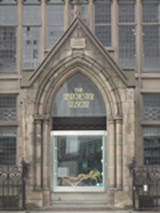 The Manchester Museum is situated on Oxford Road in the middle of the University of Manchester’s neo-Gothic buildings. The museum is owned by the university and is open to the public as well as serving as an academic research resource. It houses about six million artefacts from every continent on the globe. The Manchester Museum was designed by Alfred Waterhouse, the architect of London’s Natural History Museum, opened to the public in 1888.
The Manchester Museum is situated on Oxford Road in the middle of the University of Manchester’s neo-Gothic buildings. The museum is owned by the university and is open to the public as well as serving as an academic research resource. It houses about six million artefacts from every continent on the globe. The Manchester Museum was designed by Alfred Waterhouse, the architect of London’s Natural History Museum, opened to the public in 1888.
It first housed the collections of the Manchester Society of Natural History and the Manchester Geological Society. In 1912 a ‘pavilion’ funded in the most part by Jesse Haworth, a local textile merchant, was opened to house archaeological and Egyptological collections. This was followed in 1927 by the opening of an extension to accommodate the ethnographic collections.
More recently in 1997, the Heritage Lottery Fund awarded the Manchester Museum a £12.5 million grant and together with help from the University of Manchester, the Wolfson Foundation, the European Regional Development Fund and the Wellcome Trust, the museum was able to refurbish and re-open in 2003.
Without doubt the most impactful exhibit in the Manchester Museum’s collection is ‘Stan’, a reproduction cast of a Tyrannosauros Rex fossil, mounted in a running posture. The cast is based on the second most complete T Rex ever found, excavated by Stan Sacrison in South Dakota in 1992.
The archaeological collections in the Manchester Museum come chiefly from Western Europe, the Mediterranean, Egypt and Western Asia. So great is the Egyptological collection that a whole new wing was added to house it. The displays are stunning and the Egyptian Mummy Research Project, which began in 1973 using radiology and endoscopy, has revealed much new information on health and social conditions in ancient Egypt.
Other highlights include the Manchester Herbarium with upwards of 950,000 specimens, the Numismatic collection with a superb range of Greek and Roman coins, the Simon Archery Collection with 2000 exhibits from all over the world, Entomological collections amounting to nearly three million specimens and Geological collections with more than 9,000 mineralogical specimens and several hundred thousand fossils.
